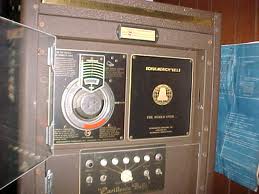The Robertson-Wesley carillon has been chiming out tunes, tolls, and peals since it was installed by the Schulmerich Company in the east room in 1961. It is not a carillon that is played with a keyboard and actual bells, but the sound is made instead by semantra (rectangular metal bars roughly the diameter of a pencil, but of varying lengths) that are struck by an electric solenoid. The resulting sound from the tone bars is electronically amplified millions of times and broadcast by a few loudspeakers which are housed in our tower.
Between the time the church was built in 1913, and until 1961, there were no tower bells. Then in 1961, the family of Frank Wolfe donated the money for the carillon, in memory of Frank. At that time, it was very expensive – around $10,000! The Wolfe family owned Edmonton Motors, and this family-run business is still owned by the next generation.
When the carillon was first installed, it was state-of-the-art. We have 26 rolls for playing music on the carillon. These rolls look like player piano rolls, and they contain hymns, seasonal music, bell peals (like the Westminster Chimes) and even classical music like “Alleluia” by Mozart. There are two sets of sounds on this carillon – a celeste harp and English bells. The cutouts on the roll dictate which sound is activated.
The carillon plays only from the rolls or by creating a “random ring” by randomly pushing any of the five notes that are on buttons. With these same buttons a toll can be rung. Before our “new” organ was installed in 1979, there was a small keyboard attached to the old organ console, which could also activate some of the tone bars. However, this small keyboard was disconnected over 30 years ago. When is the carillon used? At the moment, it plays one song every day at noon on one of the rolls. It is sometimes played after Sunday services, or after special services (Christmas, Easter, etc.), and sometimes it is random rung after weddings. Other community members get to hear it when it is played after special events, like the Alberta Baroque “Music for a Festive Season” Christmas concert. In days gone by, pealing bells have played before services, occasional tolls for funerals, and our carillon was rung for a special peace movement, where bells all over the world were played at a specific time. The carillon used to play two times a day from the rolls as well.
So, who gets to enjoy the carillon bells? Neighbours and office workers have sent us comments over the years about how much they appreciate hearing it. Church members enjoy hearing it when they drop by around noon. For those of us working in the building, the song that plays at noon is a bit of an alarm clock – reminding us to quit working and have some lunch! Wedding couples often request to have the carillon rung as they are exiting the church. It’s always a nice touch to have members listen to the carillon as they leave after a service at a special time of year.
For many years, one person in the congregation has maintained the carillon as best as he can. However, the 1961 technology is now extremely out of date, and nearly impossible to fix. The rolls are extremely brittle and have been spliced, taped, are still falling apart, and as a result, they sometimes get caught in the mechanism of the machinery. New rolls can no longer be ordered. The tube amplifiers are almost impossible to replace, and can now only be ordered from New York, at quite an expense. The mechanical and moving parts are wearing out: the spindles and rubber rollers are significantly worn down, which causes other mechanical problems. One out of five of the random ring buttons always sticks (leaving only four notes to ring which leaves far fewer combinations)! The keyboard is disconnected and the wiring is extremely brittle. The loudspeakers have served us well, but in fifty years, there is certainly better speaker technology. Occasionally the time system gets out of sync and we get reports of the carillon ringing in the middle of the night! Also the carillon mechanism takes up a lot of space in the east room.
A while ago, one of our choir members, looked into the possibility of replacement for the current carillon. He did a significant amount of research, and this material was presented to the worship committee and to the property committee. There are some digital carillons still being produced by various companies, and most of them are cheaper that the original price tag of $10,000, although some are in the $20,000 range. There is a terrific model by BRG, which is about $6000. The bell sounds have been digitally sampled from real bells. It has advanced timing and scheduling functions, GPS time receiver (so it always plays at the right time), is run by a computer with a full size color video screen, and has recordings of nearly 2,000 hymns, swinging bells, chimes, liturgical bells, etc. It has a great speaker system for increased reliability and range. The BRG model will reproduce virtually any sound that can be directly recorded into the system using CD recordings or a MP3 source. The digital sound is sent directly to the power amplifier to produce the full richness of beautiful cast bells. The sound can be produced outside or inside the church or both.
More information about the possible carillon replacement project will be forthcoming in your R-W Report and bulletins in upcoming weeks!
Tammy-Jo Mortensen, with many thanks to two additional people


